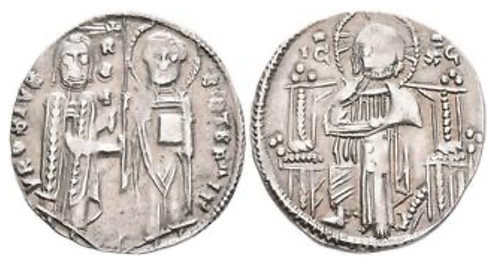
PREV ARTICLE
NEXT ARTICLE
FULL ISSUE
PREV FULL ISSUE
V25 2022 INDEX E-SYLUM ARCHIVE COINS OF MEDIEVAL SERBIAA recent Coinweek article by Mike Markowitz examines the coins of medieval Serbia. Here's an excerpt - be sure to see the complete article online for more. -Editor
Stefan Uroš I SERBIA. Stefan Uros I, king, 1243-1276. Gros (Silver, 20 mm, 1.71 g, 6 h). VROSIVS REX S STEFAN' Stefan Uroš standing facing on the left, holding akakia in his left hand, and St. Stefan, nimbate, standing facing on the right, holding book of Gospels in his left hand; both holding, between them with their right hands, long banner. Rev. Christ, nimbate, seated facing on decorated throne and holding book of Gospels with both hands; in field to left and right, IC – XC. Dimitrijevic 5. Light areas of weakness, otherwise, very fine. Starting Price: 25 CHF. Leu Numismatik AG > Web Auction 16. 22 May 2021. Lot: 4841. Realized: 55 CHF (approx. $61).
Born about 1223, Stefan Uroš I is remembered as Uroš Veliki (
An energetic ruler, Uroš encouraged mining in the kingdom, importing skilled Saxon mine workers from the gold mines of the Carpathian Mountains. He reformed the coinage, with a massive issue of silver coins modeled on the high-quality Venetian grosso that was gaining wide acceptance as an international trade currency. In numismatic references, the terms gros and dinar are both used for these coins. On the coin, Stefan stands beside his namesake St. Stephen, patron of his Nemanjic dynasty. The Latin inscription identifies him as UROSIUS REX (
To read the complete article, see:
Wayne Homren, Editor The Numismatic Bibliomania Society is a non-profit organization promoting numismatic literature. See our web site at coinbooks.org. To submit items for publication in The E-Sylum, write to the Editor at this address: whomren@gmail.com To subscribe go to: https://my.binhost.com/lists/listinfo/esylum All Rights Reserved. NBS Home Page Contact the NBS webmaster 
|


